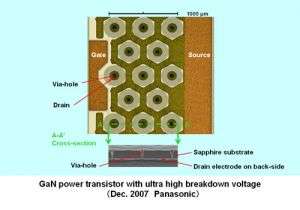Panasonic Develops a Gallium Nitride (GaN) Power Transistor with Ultra High Breakdown Voltage over 10000V

Panasonic today announced the development of a Gallium Nitride (GaN) power transistor with the ultra high breakdown voltage over 10000V. This breakdown voltage is more than 5 times higher than previously reported highest values in GaN power transistors. The new GaN transistor is applicable to high-voltage and low-loss power switching devices.
A novel device structure and a high quality GaN film on a highly resistive sapphire substrate realize ultra high breakdown voltage of 10400 V with low on-state resistance of 186 Ωcm2.
Overlap of the electrodes via insulating film on the surface side is eliminated by use of a back-side electrode with through-holes in the sapphire, which results in the ultra high breakdown voltage. The through-hole in chemically stable sapphire is formed by a novel laser drilling technique using a high power pico-second laser.
In addition, Panasonic's proprietary epitaxial growth technology greatly helps to extract the superior inherent material property of GaN resulting in the high breakdown voltage together with the low on-state resistance. This new GaN power transistor with ultra high breakdown voltage is applicable to high voltage power switching devices for industry and electrical power systems.
Applications for one hundred and ten domestic and sixty nine international patents have been filed. These research and development results have been presented at International Electron Devices Meeting 2007, held at Washington D.C., U.S. from December 10 to 12, 2007.
Source: Panasonic





















